Horror is rife with mommy issues. Pick up nearly any film in the genre and you’ll find cruel mothers, smothering mothers, tormented mothers, violent mothers, abused mothers, mothers who are killed by their husbands, mothers who kill their husbands, mothers who kill their children, and mothers who kill themselves.
While horror’s preoccupation with mothers has produced truly amazing works of art, horror films about motherhood are too often plagued by unquestioned assumptions about the purity and redeeming sacrifice of maternal love. Though protagonists are allowed to behave monstrously in moments, even most ostensibly feminist films balk at any challenge to the idea of that all but the most craven and depraved of women will and should place their children’s (real and/or hypothetical) lives above their own. Films that grapple with supernatural embodiments of negative or ambivalent feelings motherhood tend to find resolution when their leading moms come to a place of acceptance about their role. There’s nothing necessarily wrong with this story (Jennifer Kent’s wildly influential The Babadook does it beautifully, for instance), but it’s often a bit discouraging that so many films who claim to be interested in the complexities of motherhood seem entirely uninterested in challenging idealized notions of maternal martyrdom and family values.
As a bit of a “mommy-horror” aficionado, I was as excited for Huesera: The Bone Woman as I was trepidatious about the possibility of another horror entry about motherhood that falls into old tropes. Luckily for me, Huesera surprised me in the best possible ways.

*Light spoilers to follow*
The basic premise of Huesera doesn’t differ significantly from most entries in the mommy-horror subgenre. A young couple, Valeria (Natalia Solián, an absolute star from her first seconds onscreen) and Raúl (Alfonso Donsal), find out that they’re expecting a baby. Raúl is overjoyed, as is Valeria’s mother. Valeria also seems excited—at least initially—but this excitement is tempered by the ever-increasing sense that, by becoming pregnant, Valeria has inadvertently trapped herself in an ill-fitting domestic role.
As Valeria begins seeing visions of spiders and a strange woman (or is it women?) with broken bones and no face, Raúl’s doubts about her sanity and frustration with her odd behavior begin to drive a wedge between them. Valeria’s family, who already seem to view her with a certain level of bemusement, are similarly put off my her ambivalent reaction to her pregnancy. Her world becomes smaller and smaller as her loved ones lose both their trust and their patience with her. Only her “spinster” aunt and Octavia, an ex-flame from Valeria’s more radical past, seem to have any interest in Valeria’s account of her own reality.

One of Huesera’s many strengths is its performances. While Solián is the beating, bloody heart of the film, everyone pulls their weight here. Donsal does great work, deftly maintaining Raúl’s affable charm even as he reveals darker, more controlling shades of his character. Mercedes Hernández is responsible for some of the film’s best emotional notes as Valeria’s Aunt Isabel. Particularly surprising was Mayra Batalla as Octavia. Though, the way in which this character subverted my expectations has just as much to do with writer and director Michelle Garza Cervera as it does with the actress playing her.
As the “former lover from a wild past,” characters like Octavia generally serve as little more than plot devices, particularly when—like Octavia—they’re queer. Lacking inner worlds of their own, these blank slates with hastily-applied counter-cultural markers act as vessels into which the protagonists can overflow with repressed emotion and desire. While it’s true that Valeria uses Octavia in a similar way, Huesera seems self-aware of this fact. And Octavia, with help from a compelling performance by Batalla, is a full character with an inner life of her own. The atmosphere in the scenes between these Octavia and Valeria is thick with chemistry, as well as a sense of genuine intimacy that contrasts with Raúl and Valeria’s more friendly, playful relationship.
One of the most exciting surprises of the film was discovering that Huesera’s queerness isn’t simply relegated to a throwaway character or a brief moment in the protagonist’s past. Not only is the audience blessed with three fleshed-out, well-written queer characters (as well as an array of side characters), but the themes of the film itself are deeply queer as well. Cervera’s choice to approach the horrors of domesticity through the lens of queer assimilation is a brilliant one that both amplifies and gives new shades of complexity to Valeria’s discomfort with her maternal role. Valeria’s pregnancy is simultaneously liberatory and oppressive, bringing to light the ways in which she is trapped in a cycle of centering her life around the happiness and comfort of her family (to the detriment of her own happiness) even as it further entrenches her in this trap. Cervera and Solián convey this subtly, relying on small moments of potent emotion instead of overstuffed dialogue. For the duration of the film, I clearly felt that Cervera was telling a story about queer people for queer people, rather than handholding for a straight audience.
There was one scene in particular that stood out to me. Early in the film, before any characters are explicitly acknowledged or coded as queer, Valeria allows Isabel to take her to a curandera to gain insight into her difficulties with her pregnancy. While Valeria waits for her appointment, Isabel goes to greet her friends. The older women laugh and drink and chat with each other with affection and ease. One of the women puts her arm around Isabel in a way that could be read as romantic, but with enough of a light touch to retain plausible deniability. In just a few short moments, Cervera is able to establish a powerful sense of intimacy and kinship within Isabel’s group of friends. Watching this, I felt an acute longing to be with the groups of queer people like this in my own life. As I felt this, I saw that the expression on Valeria’s face mirrored my own. Immediately, I knew who Isabel was and who Valeria was, and saw Valeria’s relationship with her family, husband, and even her own body in an entirely different light.
This scene also highlights Cervera’s skills as a visual storyteller. Her work with cinematographer, Nur Rubio Sherwell, and editor, Adriana Martínez, is a beautiful argument for letting the visual language of a film speak for itself rather than constantly reinforcing it with expository dialogue. The camerawork is thoughtful, efficient, and confident. While using the camera to create a sense that someone or something is watching the protagonist is hardly novel (particularly in horror), the way this is done in Huesera somehow manages to give the impression that Valeria is watching herself from the same position as the unseen entity, which serves as a clever way to underscore her sense of alienation from her own life.

There’s another moment towards the end of the film where a POV shot of a compound eye neatly threads the needle between the film’s two main visual motifs. Again, Cervera and her team accomplish this important moment without using dialogue to hammer the point into the ground. Huesera’s trust in its audience and its deep understanding of the power of visual language is one of the film’s greatest strengths.
The production design is similarly strong and contributes heavily to building a clear vision of Valeria’s world, as well as to many of the film’s best scares. The central monster, an elevated version of the “creepy woman with jerky, anatomically-suspect movements” type, is brought to life through some particularly effective sound design that carries over into Valeria’s own knuckle-cracking habit. Interestingly, the sound design is most restrained in moments of shock, which works nicely to turn what could’ve been jump scares into more subtle thrills.
Save for a couple of shaky visual effects, the horror in Huesera is tight, restrained, and effective. Though it’s not the scariest film I’ve ever seen (nor do I feel like it’s aiming to be), the sustained tension is effective and there are a few genuinely shocking moments. Horror films centering around pregnancy and babies can either slant too tame, with the audience never able to fully suspend their disbelief that the infant might come to real harm, or can veer into shock for shock’s sake territory. Huesera neatly toes the line between the two. While viewers are acutely aware throughout the run of the film that anything might happen to Valeria and her baby, Cervera cleverly pivots to a different kind of shock at the film’s conclusion.

Huesera’s bold resolution frames the entire film in a different light. We already know that it’s not a simple allegory about the fears of new motherhood, but it doesn’t turn out to be a straightforward commentary on gender roles either. Instead, it re-examines the very idea of what is horrifying about pregnancy and motherhood, and of what mothers owe to their children, to their families, and to themselves.
Huesera: The Bone Woman will open in theaters on February, 10th and will be available on VOD on February 16th from XYZ Films. Run, walk, crawl, or slither over to your local theater to check it out!



